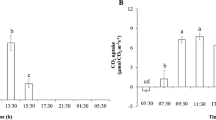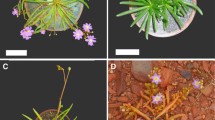Abstract
WHEREAS considerable information is available regarding the enzymatic mechanism of carbon dioxide fixation during acidification in succulents1–3, very little seems to be known about the role of enzymes in the diurnal variation in acids and carbohydrate. If the 3-carbon atom acceptor of carbon dioxide is derived from starch or sugar by the Embden–Meyerhof–Parnas series of reactions, aldolase may be expected to play an important part in the processes of acidification and de-acidification. We have studied the activity of aldolase in cactus tissue at different hours of the day and night, and have found a marked diurnal variation. Phosphatase activity was also found to undergo rhythmic alteration.
Similar content being viewed by others
References
Walker, D. A., Biochem. J., 67, 73 (1957).
Walker, D. A., and Brown, J. M. A., Biochem. J., 67, 79 (1957).
Walker, D. A., Biochem. J., 74, 216 (1960).
Sibley, J. A., and Lehninger, A. L., J. Biol. Chem., 177, 859 (1949).
Sanwal, G. G., and Krishnan, P. S., Enzymologia, 22, 51 (1960).
Author information
Authors and Affiliations
Rights and permissions
About this article
Cite this article
SANWAL, G., KRISHNAN, P. Diurnal Variation in Aldolase and Phosphatase Activity in the Cactus Plant. Nature 188, 664–665 (1960). https://doi.org/10.1038/188664a0
Issue Date:
DOI: https://doi.org/10.1038/188664a0
- Springer Nature Limited
This article is cited by
-
Desert plant chemurgy: A current review
Economic Botany (1973)
-
Diurnal variation in the activities of isocitrate and glucose-6-phosphate dehydrogenases in cactus phylloclades
Experientia (1971)
-
Diurnal variation of the acid phosphatase activity in the leaves of Cowpea
Planta (1967)
-
Diurnal Variation in Transaminase Activity in the Cactus Plant
Nature (1961)





